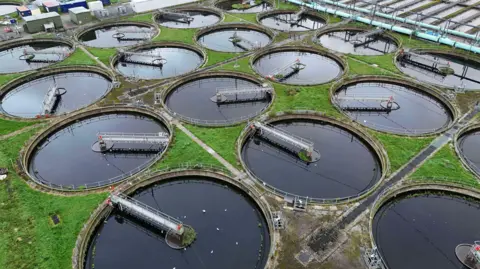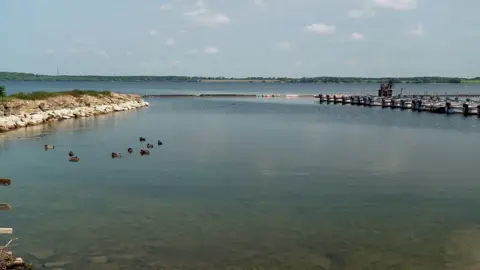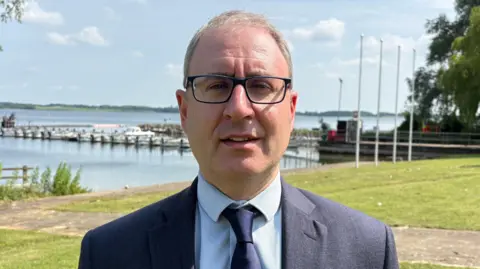'Cool data centres with treated sewage' - water firm
 EPA
EPALarge data centres should be cooled with "treated sewage effluent" rather than drinking water, according to a water company.
Anglian Water's head of planning said they should be located near water recycling plants, so they could more easily access supplies.
Giant data centres are needed to power artificial intelligence (AI) - but require water to stop them overheating.
The Environment Agency has highlighted a growing demand for water from data centres and some in the water industry fear the growth of AI could lead to water shortages.
A spokesperson from the Data Centre Alliance disputed that they needed large volumes of water for cooling, but did not object to using treated sewage.
 Steve Hubbard/BBC
Steve Hubbard/BBCThe government has committed to building more AI infrastructure and invited areas to apply to become "AI growth zones", with the first earmarked for Culham, Oxfordshire.
Applicants must have a letter of support from their local water supplier.
Geoff Darch, head of strategic asset planning at Anglian Water, said the company had received "expressions of interest for AI growth zones, but also for specific data centres".
He said if a developer approached Anglian asking for a regular tap water connection for a large data centre in a water-stressed part of its region, "our immediate response would be that that's going to be challenging".
He added: "We do have a limit on the amount of water - potable drinking water - that we're allowing for those kind of uses at the present time."
 Ben Schofield/BBC
Ben Schofield/BBCThe company was "encouraging people to look at alternative sources of water" including "treated sewage effluent", he said.
"It's possible we won't need to use drinking water to cool these facilities. We could use things like treated sewage effluent, that could be equally good to cool these data centres."
Mr Darch said data centres and hydrogen production would be two significant future industrial demands for water.
He said they might only account for "single digit" percentages of the total water Anglian supplies, but that could equate to "tens of millions of litres [of water] per day".
"Our region is a water scarce region - we don't necessary have that volume of water immediately available - so what we're looking to do now is identify these new demands for water and start planning the infrastructure, so things like new reservoirs, pipelines, that actually can meet the demands that these things will require in the future."
 Reuters
ReutersAnglian supplies water to homes and businesses in Northamptonshire, Bedfordshire, Milton Keynes, Norfolk, Lincolnshire and parts of Cambridgeshire, Buckinghamshire, Hertfordshire, Suffolk and Essex.
Its neighbouring supplier in Cambridge - one of the country's most important technology hubs - said that it "would only be in a position to support applications" for an AI growth zone in its area "if we believe water could be supplied sustainably and without impacting our existing customer supplies and resilience".
Cambridge Water said the "water resource challenge in the Cambridge area" was "well documented" and that it was working with Anglian on a transfer from Grafham Water as well as a new 1.9 sq-mile (5 sq km) reservoir in the Cambridgeshire fens to help boost supplies.
Those plans, it added, would support "the planned growth in the region" and reduce the amount of water the company pumps from chalk aquifers, which feed the area's chalk streams.
Mr Darch said Anglian was also looking into desalination so seawater could be used onshore.
He said that the balance between supply and demand for water was becoming "increasingly tight" and that "we've got to start thinking more in a kind of scarcity mindset".
'Very small amounts of water'
Data centres were named "critical national infrastructure" in September, meaning they would get extra government support during a major incident, such as a cyber attack, IT outage or extreme weather, in order to minimise disruption.
John Booth, who chairs the Data Centre Alliance's energy efficiency and standards committee, said he "would not see a problem" with using "pumped effluent from the very last stage of a sewage plant" for cooling.
Water, he added, would be treated by the data centre before going into the cooling system.
But he said he believed fears over data centre water use was based on what US sites consumed.
He said American centres often used "evaporative cooling", which involves spraying water onto a heat exchanger and was designed for when the temperature outside reached 28C.
The large data centres he has visited in the UK use "closed loop" cooling systems, which did not require continual supplies of water.
"The figures that I get from the data centre managers reflect very small amounts of water use on an annual basis - and we're measuring it in gallons, not cubic metres, a year."
He added that he believed those who feared water shortages were "panicking when there's probably not that big a deal."
But he said it was not known how much water data centres in the UK used overall.
Elizabeth Orchard, from the Institution of Civil Engineers, said data centres "predominantly" used closed loop cooling systems, which were an "emerging best practice".
They required a "big initial demand" of water to "charge up" but not continual supplies, she said.
On using treated sewage, she added: "It's a known, viable technology - it's very sensible.
"If there's a suitable source of treated effluent nearby, then yes - crack on."
Follow Cambridgeshire news on BBC Sounds, Facebook, Instagram and X.
